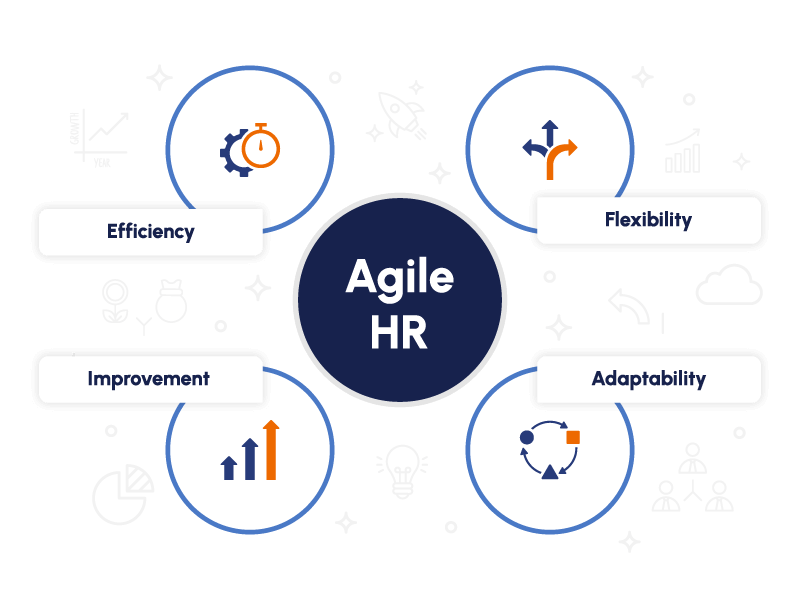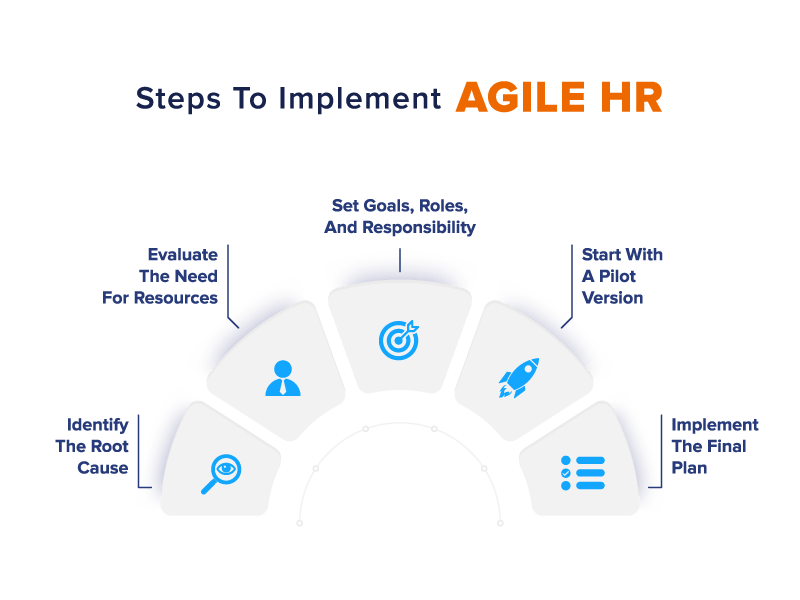Agile HR: What it is and How it can Change the Workplace Dynamics
Table of Contents

The term ‘Agile Approach’ these days is frequently used in modern workplaces. In the aggressively competitive world, businesses need an approach that sustains and gives them an upper hand over their competitors. Agility initially was just related to project management and development. It is an approach where the projects are divided into smaller parts for completion and execution. The reason behind dividing the development into a smaller sprint cycle is to identify the issues and errors and have a wide scope for correcting them. Resulting in the project's successful completion with no or minimum error at the exact cost.
But now, this approach is not just limited to development. Companies have started applying it to different functions, one of which is HR. Human resource management is crucial to any organization, and its approach must be faultless. However, systematic planning and excellent execution of HR processes are now not enough for a successful end result. All the processes now need modernization and an innovative approach. An organization runs through people, and that is why people management can not be neglected. Unfortunately, today it seems like there is no space left for the traditional HR approach. Hiring, recruitment, training, and sustaining the employees are some of the core HR functions that need to be carried on efficiently.
This article is all about an agile approach towards HR, which is a need for modern businesses today to have a positive change in workplace dynamics.

Agile Approach In HRM
Let's first start with a fundamental question: what does agile HR mean? Agile HR refers to structuring the HR functions to facilitate the quick adaptation of situations and flexibility in shaping the workforce. The agility of HR contributes to the organization’s responsiveness toward its employees' needs. Additionally, agility in human resource management is a strategic method to operate HR functions and make them more effective and efficient, which helps HR to be more reactive to the transforming workplace environment and adaptable to manage processes changing quickly. Apart from this, it simplifies and automates time-consuming HR tasks and helps execute fast and critical policies and decisions.
The meaning of agile HR can be better understood with an example:
A tech company decided to rebuild and modernize the performance management process.
- First, the executive management prepared a structure and designed the whole process.
- Then, a pilot version was introduced, and feedback from the employees was taken.
- As per the feedback, required changes were made to the process.
- The final version was then implemented in the organization.
The second question arises here: do organizations really need an agile approach for HRM? The answer is a big yes. To meet the standards in reality and to cope with the frequently changing circumstances, the agile approach is one of the best options an organization can choose. An agile HR is analytical and data-driven as well as it undertakes intelligent decisions and suggests strategic activities as a way to enhance the productivity and performance of employees. Business departments and functions highly require agility as its flexibility allows them to innovate and adapt strategic habits. As a result, such an approach is flexible to the evolving changes and highly receptive to the one anticipating them.

Steps to Implement the Agile HR Approach
A survey report from Gartner states that 63% of HR leaders are now planning to implement the agile approach. But it's challenging for HR leaders to shift from the traditional approach to an agile approach, and it can neither happen drastically. Instead, the process is gradual, and even the smaller steps initially can benefit. But most importantly, it depends on the way it is implemented. A correct way can do wonders, and in contrast, an undefined and unstructured implementation plan can bring negative results. All it requires is an appropriate and suitable plan for the organization. Below mentioned are some of the common steps which can be followed for smooth implementation:

Identify the Root Cause
It starts with identifying what HR processes are failing, what are the causes, and which one needs a change. Without recognizing the root cause for the inaccurate process, how will the changes be made? Even it's not necessary to change the ways that are already working well. Therefore, figuring out the causes and issues is mandatory to frame a better plan.
Evaluate the Need for Resources
Once the causes are identified, the next step is to take action against them. Usually, a team is dedicated to doing further planning for each process. At the same time, the phase of making the changes can bring the requirement for additional resources. The need might be in terms of money, human resource, or any other need.
Set Goals, Roles, and Responsibility
After plans are made, and outlines are prepared, it’s time to set goals. The strategy has to be divided into small segments, and priority is to be defined for each one of them. Priority tasks need to be implemented, and for that, the roles and responsibilities are to be delegated to the employees. Finally, the whole team must work together and frequently update about the progress of the process.
Start With a Pilot Version
Most of the time, it is beneficial to implement a pilot version and observe the changes initially. Starting with a smaller sprint will be suitable for both the management as well as the employees. It gives time to adapt to the changes and work as per the new framework. The pilot versions usually last for 3 to 4 weeks, and then the observations and feedback are noted.
Implement the Final Plan
The final plan will be executed after the required changes are made. Most of the time, when the plans are practically implemented, some loopholes are identified, which require changes. Feedback from each and everyone involved in the process is necessary as each one of them can have a different point of view which can result in the betterment and enhancement of the plan. After implementing the final version again, evaluating them is beneficial.

Gains of Agile HR Approach
The popularity of the agile HR approach has increased as it brings multiple benefits to the organization. It is a way through which they can cope with modern-day business challenges. And as businesses are noticing the positive outcomes, the applicability of this approach has increased. However, as per the type of organization and its needs, all of them can have diverse gains. So, here mentioned are some commonly expected gains that human resource management will notice:
Improved Adaptability and Flexibility
One of the biggest advantages HR managers get through this approach is its quick adaptability and flexibility in any circumstances. Many times predictions made don't work and bring a completely different situation in front of management. Such as, the pandemic was uncertain, and many companies could not handle the changes and suffered losses. Therefore when the approach is flexible, all uncertain situations can be tackled.
Better Employee Experiences
The agile approach emphasizes making employee experiences better. For example, when the plans are created, it brings cross-functional teams together, which makes better involvement. Also, the feedback is taken from employees that make them feel valued by the organization. In short, it creates a co-created experience for employees to work.
True Feedbacks
The feedback from employees on a regular basis can be obtained, and HR managers can work to enhance it further. Opinions, reviews, and feedback are taken after implementing a pilot version; therefore, they can bring out the real issues the employees face. As a result, Identifying the problems becomes less complicated.
Modern Approach and Risk Management
The agile approach modernizes most of the traditional ways of performing the HR process. The process goes through a transformation, which also brings technological advancement to the organization. Also, the plans are framed in a way that can predict risks. Preventive measures can be taken to eliminate risks to some extent.
Attracting top Talents
When the HR process is effective and offers an advantage to the workforce, it makes the organization suitable for other candidates to join. However, even this can give an upper hand over the competitors in attracting the best talents and retain, resulting in a lower employee turnover ratio.

Use Case of Agile HR
HR managers apply this approach to different human resource management processes. The below mentioned is the use case of commonly known HR function recruitment and hiring. It will help you better understand Agile HR with the actual incidents in the organization.
Recruitment and Hiring
- An IT company's HR managers identified that their recruitment and hiring processes are slower and outdated.
- The HR leaders decided to initiate the agile methodology.
- They usually had a recruitment cycle of 18 to 20 days, starting from identifying the job vacancies to selecting the candidates.
- The aim was to reduce the time period of the recruitment cycle.
- Managers identified that most of the time is consumed in screening and selecting after the interview is conducted.
- Managers changed the traditional way, and they adopted recruitment software with an applicant tracking system.
- Along with that, the managers also decided to complete the process of selection in a maximum of 2 to 3 days after the interviews are conducted.
- Through agile methodology, the process was carried out through tech tools, and procedures that were delayed unnecessarily for no reason are conducted fast.
- Opting for the agile approach reduced the time of the recruitment and hiring cycle from 18 to 20 days to 10 to 15 days.
Conclusion
An agile approach toward human resources can indeed change the workplace dynamics positively. Agile is all about improvement, efficiency, collaboration, adaptability, and flexibility. The transition from traditional methods to agile may take time, with some hurdles in between. But consistent efforts by the team can transform the HR process making it efficient and effective.

People also search for
Frequently Asked Questions
How does the Abilene Paradox differ from Groupthink?
On the whole, both the situations are similar with only one difference.
In groupthink, all the individuals participate collectively for a discussion as a cohesive group. They altogether agree with the group’s final decision both individually and as a team.
On the contrary, in abilene paradox, the individual members agree with the decision as a team so that they don’t upset anyone in the group. But their personal thoughts don't match or are opposite from the collective decision.
What are the symptoms of abilene paradox?
Your organization is caught into abilene when the employees in a group shows the below symptoms.
- Employees agree about individual problems or organizational losses privately but not in a group discussion.
- Employees fear to suggest steps needed to resolve an issue collectively but do so one-on-one.
- Due to fear of isolation and miscommunication, their thoughts are really expressed well. Their actual and private opinions always differ from what they agreed to as a team.
- Decisions taken in the influence of paradox are often poor, which may result in failure of the action. Employees, thus feel anger, frustration and dissatisfaction towards the organization.
- Employees with similar thoughts may start creating micro-groups and target other groups for downfalls.
Modify your HR and payroll tasks with factoHR today
Let your HR and workforce focus on most important business decisions while factoHR can reduce the burden of daily activities of the organization.


